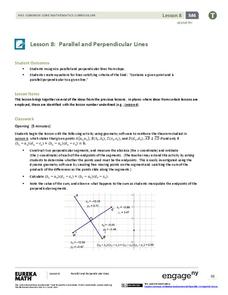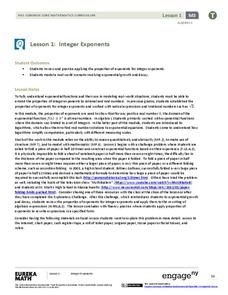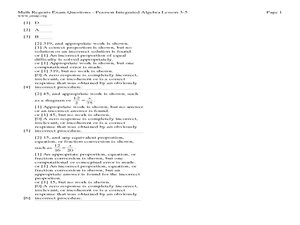Curated OER
Rounding Decimals, from Hundredths Place to Whole Numbers
An efficient and straightforward decimals learning exercise! Young learners round amounts of money and measurements to the nearest dollar or meter. Each section contains 20 problems, making it easy to divide up this asignment into...
Houston Area Calculus Teachers
Area and Volume
An AP calculus lesson begins with an activity to determine the volume of a solid using a cross-section. Next, learners review the ways to find the area between two curves , as well how to find the volume of a solid created from the...
California Education Partners
Tile Mural
Paste this resource into your lesson plans like you'd paste a tile onto a mural. Given a diagram of a tile mural with rectilinear figures, future artists determine the perimeters and areas of the figures. They must then develop their own...
Berkshire Museum
Where’s the Water?: Acting Out Science Cycles
Young scientists transform themselves into rivers, oceans, clouds, and drops of water in order to explore the water cycle. After assigning and explaining to students their different roles in the activity, the teacher reads aloud a...
Curated OER
Measurement Enrichment Worksheet- Using Mouse Measures
In this measurement enrichment worksheet, 2nd graders use a picture of a mouse as a unit of non-standard measurement to complete a chart. They record the shortest items and longest item in 2 questions below the chart.
Curated OER
Explore Addition and Subtraction of Decimals
Exploring problem solving involving the addition and subtraction of decimals can be done with word problems. In this worksheet on decimals, students add and subtract distances measured in miles and expressed as decimals. This worksheet...
Curated OER
Measure Up- How Many Pounds in All?
In this adding pounds instructional activity, 1st graders complete 6 problems. They use the picture bank at the top of the page that shows the weight of 6 objects in pounds. They look at the pictures in each problem and match them to...
Curated OER
Hands On: Construct Triangles and Rectangles
In this congruent triangles and rectangles worksheet, students solve 6 word problems where they identify whether triangles and rectangles are congruent, and construct triangles. Students must explain their reasoning and prove each answer.
Curated OER
Ag In The Outfield
Young scholars explore baseball. This is a cross-curricular plan that includes math, history, and agriculture. Pupils use their five senses to observe the materials a baseball is made from and identify the agricultural products used. In...
K12 Reader
Eratosthenes: Geographer and Mathematician
Mathematicians can be famous, too! Introduce your class to Eratosthenes with a reading passage. After they complete the passage, learners respond to five questions, some of which require opinions and others reading comprehension skills.
EngageNY
The Scaling Principle for Area
As they investigate scaling figures and calculate the resulting areas, groups determine the area of similar figures. They continue to investigate the results when the vertical and horizontal scales are not equal.
EngageNY
Informal Proof of AA Criterion for Similarity
What does it take to show two triangles are similar? The 11th segment in a series of 16 introduces the AA Criterion for Similarity. A discussion provides an informal proof of the theorem. Exercises and problems require scholars to apply...
Virginia Department of Education
Angles, Arcs, and Segments in Circles
Investigate relationships between angles, arcs, and segments in circles. Pupils use geometry software to discover the relationships between angles, arcs, and segments associated with circles. Class members use similar triangles to...
EngageNY
Understanding Box Plots
Scholars apply the concepts of box plots and dot plots to summarize and describe data distributions. They use the data displays to compare sets of data and determine numerical summaries.
EngageNY
Describing a Distribution Displayed in a Histogram
The shape of the histogram is also relative. Learners calculate relative frequencies from frequency tables and create relative frequency histograms. The scholars compare the histograms made from frequencies to those made from relative...
EngageNY
Parallel and Perpendicular Lines
Use what you know about parallel and perpendicular lines to write equations! Learners take an equation of a line and write an equation of a line that is parallel or perpendicular using slope criteria. They then solve problems to...
EngageNY
Integer Exponents
Fold, fold, and fold some more. In the first installment of a 35-part module, young mathematicians fold a piece of paper in half until it can not be folded any more. They use the results of this activity to develop functions for the area...
EngageNY
Conversion Between Celsius and Fahrenheit
Develop a formula based upon numerical computations. The 31st part of a 33-part unit has the class determine the formula to convert a temperature in Celsius to a temperature in Fahrenheit. They do this by making comparisons between the...
EngageNY
End-of-Module Assessment Task - Grade 8 Mathematics (Module 3)
Everything the class knows about similarity in one small package. The last portion of a 16-part series is a three-question assessment. In it, pupils demonstrate their application of similar figures and their associated transformations.
Curated OER
Reflection: Student Worksheet
In this math worksheet, students will work independently to trace a stencil on an x-axis. Then students will follow a procedure to trace the image on the horizontal line of reflection. Students will observe that reflections and rotations...
Curated OER
Coordinate Plane Worksheets - Area of Rectangle
In this online math activity, students calculate the area of a variety of rectangles given the measure of their vertices. This excellent resource allows the students to check their answers, and to get "hints" should they run into...
Curated OER
Lesson 3-5: Proportions and Similar Figures
In this similar figures activity, students use proportions to solve 6 short answer and multiple choice questions. Students use proportions to answer questions about map scales and height of trees given shadow lengths.
Geophysical Institute
Latitude and Longitude with Google Earth
Travel the world from the comfort of your classroom with a instructional activity that features Google Earth. High schoolers follow a series of steps to locate places all over the earth with sets of coordinates. Additionally, they...
Indian Institute of Technology
Could King Kong Exist?
The title says it all: Could King Kong exist? Investigate how increasing the dimensions of an object affects its surface area and volume to mathematically conclude whether a creature with the weight and height of King Kong could actually...

























